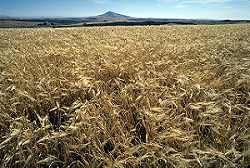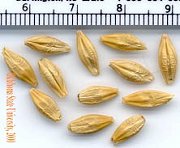Previous Page | Right click this page to print.
Barley

In the U.S., barley is the third most important cereal grain. In the U.S., for 2001, the estimated total production of barley grain is 249 million bushels. Barley is grown in cool, dry climates. Barley is one cereal grain that grows well in short growing seasons. In the U.S., barley is primarily grown in the Intermountain West and the Upper Great Plains regions. In addition, a significant amount of barley is grown in Canada. As barley is grown in proximate regions, barley is a relatively important feedstuff for the Pacific Northwest. Figure 4.11 illustrates a field of barley in the state of Washington. In addition to its primary use as a feedstuff, barley is also used in the brewing industry. Malt barley is used in the production of beer. Brewer’s grains are one by-product feed from the brewing industry. Brewer’s grains will be discussed later. Another by-product of the industry is the barley hulls. The type of barley grown primarily for feeding is termed feed barley. The primary feed barley is hull feed barley. The estimated average yield for barley grain is 58.2 bushels per acre.
Figure 4.12 illustrates barley grain on the head.

Figure 4.13 illustrates barley grain.

Additional divisions of barley are based on the presence of hull, planting season, number of kernel rows in a spike, kernel color, and texture of awn. The awn consists of the bristly fibers on the head of the plant.
Barley is classified as a coarse grain. The coarse grains are the cereal grains with relatively low energy contents, especially for monogastrics.
Table 4.4 summarizes the average nutritional composition of barley grain.
Nutrient |
Average
Composition, % |
|---|---|
Crude protein |
13.3 |
Ether extract |
2.0 |
Crude fiber |
6.3 |
Ash |
2.7 |
NFE |
75.7 |
Starch |
64.6 |
As an energy source, barley has a significantly lower feeding value than corn and milo. Factors that reduce the energy value of barley include relatively low starch content, high fiber content in the hull, and presence of beta-glucans. Beta-glucans are water soluble carbohydrates present in the bran of plants of the grass family. Beta-glucans are indigestible by mammalian enzymes and digestible by microbial enzymes. For monogastrics, beta-glucans can decrease intake and nutritional value of other nutrients. As a protein source, the crude protein content of barley is higher than corn. Compared to corn, barley has higher a lysine, tryptophan, methionine, and cystine contents. The crude protein content of barley is similar to wheat. Similar to other grains, barley is processed to improve nutritional value. Barley is a palatable feed for ruminants and horses. However, for monogastrics, barley has a relatively low palatability because of the hull.
For feedlot cattle and dairy cattle, barley is often used in combination with other grains such as corn. Excessive feeding of barley can limit energy density of the ration and can also cause bloat in ruminants. For swine, barley is often fed with other energy sources for optimum feeding efficiency. For poultry, the amount fed is limited because of the energy density of and the beta-glucans in barley. For horses, barley may also be fed in combination with other grains.
Previous Page | Right click this page to print.